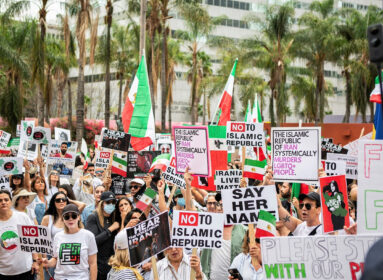By Ozzie Nogg ~
Once upon a time in 1320, a wealthy Jewish family in Barcelona said, “We need a magnificent Haggadah to grace our Passover Seder.” And so they commissioned artists to create such a manuscript. The artists took sheets of vellum and quills plucked from geese, and wrote the Hebrew text in black iron gall ink and applied gesso and bright pigments to the pages and drew miniature scenes from the Book of Genesis on gold leaf backgrounds and when the artists’ work was done they presented the family with the illuminated Golden Haggadah.
Other sumptuously illustrated and gloriously calligraphed medieval Haggadot include the Bird’s Head Haggadah, the Prato Haggadah and the legendary Sarajevo Haggadah. When the first Hebrew printing press opened in Prague in 1512, scribes could buy the printed Prague Haggadah (1526), embellished with sixty woodcuts designed to bring the Passover story to life.
Today, there are an estimated 3,000 to 5,000 different illustrated versions of the Haggadah. And since the text tells us, “In every generation, each of us is obligated to see ourselves as having come out of Egypt,” Haggadah art often serves as a barometer of how the political, social and cultural winds are blowing. Consider the story of the Four Sons.
The wise son is traditionally shown as a passive scholar wearing glasses, his delicate back hunched over a book. Four hundred years later, the drawing of the wise son by Tzvi Livni in The Socialist Zionist Haggadah (1955) shows a smart kid holding the traditional book, but this sun-burnt teenager is dressed as a pioneering kibbutznik, a symbol of the newly triumphant Zionist socialist spirit of the young State of Israel, a member of the generation who will reject the old ways in favor of Jewish nationalism.
In many early Haggadot, the wicked son is depicted as a helmeted soldier armed with dagger, sword, club and shield. In the 1879 Chicago Haggadah, the wicked son is a newly-minted American businessman, smoking at the seder — the son who thumbs his nose at his parents’ old-world traditions, a symbol of the generation gap and cultural divide between immigrants and their assimilated children. By 1959, in the Clashing Cultures Haggadah illustrated by Siegmund Forst, the wicked son (who resembles the Marxist Leon Trotsky) has morphed into a Jewish socialist revolutionary with his ax raised against the Ten Commandments, in conflict with his elderly ultra-orthodox Eastern European ancestors.
The simple son and the child who does not know how to ask have received make-overs, too. Today, they appear in contemporary guises — a kid wearing a baseball cap; a little lamb that follows blindly; a toddler asleep beside a mother goose; a baby with a binky. My personal favorite? The Comedy Trans/gender Queer Liberation Haggadah by Reuben Zellman,
MC Ettinger, Sierra Springarn and Rachel Kliegman. This version brings us the Eco-Feminist Crusty Punk Rock Vegan Hypochondriac Child who asks, “Was this Haggadah printed in a union shop on 100% post-consumer recycled hemp paper using soy ink that was not tested on animals, and has anyone seen my inhaler?” Gotta love it.
No overview of Haggadah illustrations is complete without a deep bow to the Szyk Haggadah, cited by The Times of London as “worthy to be placed among the most beautiful of books that the hand of man has produced.”
Created by Polish-Jewish artist Arthur Szyk in Lodz, between 1934 and 1936, the Haggadah combines illuminated miniatures with biting satire. In forty-eight watercolor and gouache paintings, Szyk’s visual commentary equates the genocidal Pharaoh of the Passover narrative with Adolph Hitler, and draws vivid parallels between the oppressive Egyptian bondage and tyrannical Nazi Germany of the 1930s. The first edition of the Haggadah was printed in London in 1940, but only after pressure from the publisher forced Szyk to remove the more blatant political references, such as the swastikas on the armbands worn by the Egyptians who oversaw the Hebrew slaves. Szyk’s illustration depicting the wicked son as a blond Aryan with a Hitler-like mustache, remained. Szyk immigrated to New York in 1940 where he became an advocate for the rescue of European Jewry and a supporter of Israel’s struggle for independence.
In Haggadah and History (1975) the late professor Yosef Hayim Yerushalmi observed, “The Haggadah as a book is, time and again, inseparable from its role as a mirror of history itself. No matter from which angle the printed Haggadah is approached, sooner or later we confront some significant development of the last five hundred years, some modicum of knowledge concerning the time and place in which they were printed.”
Ozzie Nogg (www.rabbisdaughter.com) looks at the history and observance of Jewish holidays, festivals and life-cycle events.








 Southern New England Jewish Ledger
Southern New England Jewish Ledger












